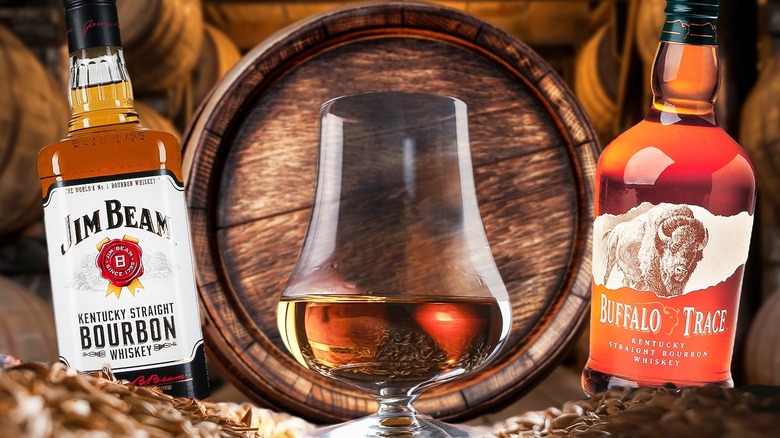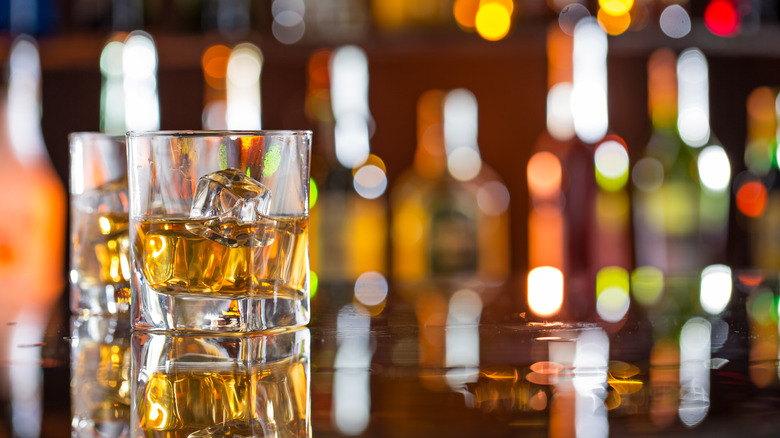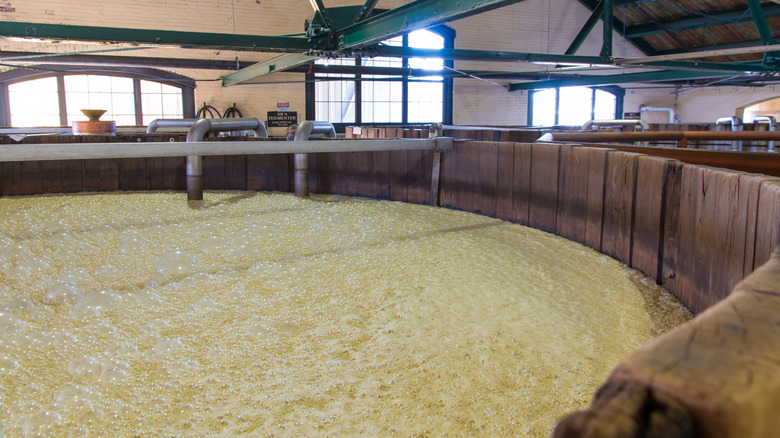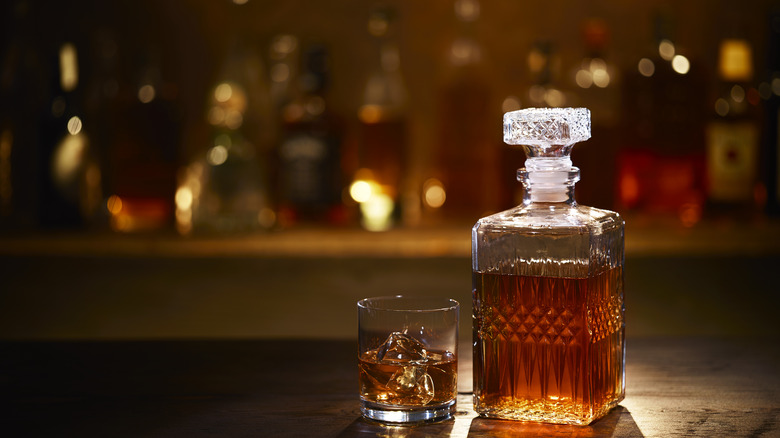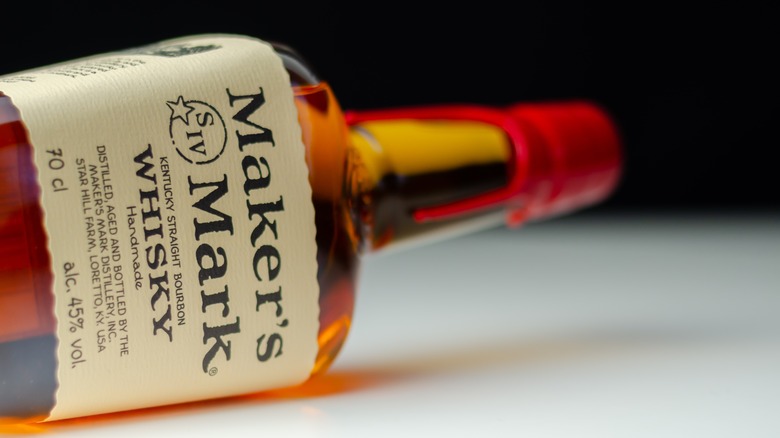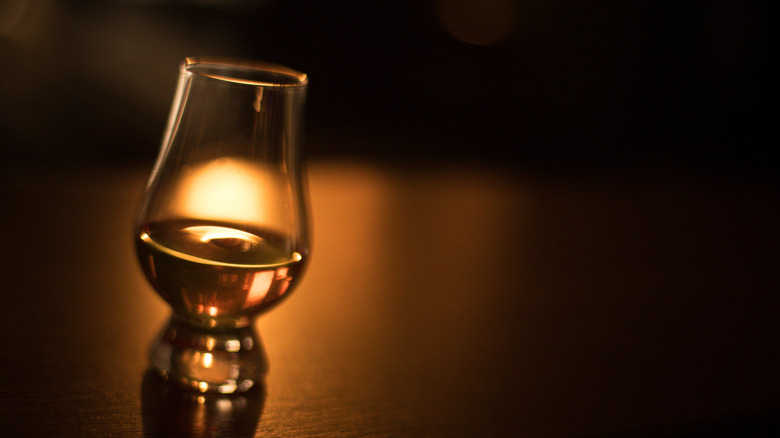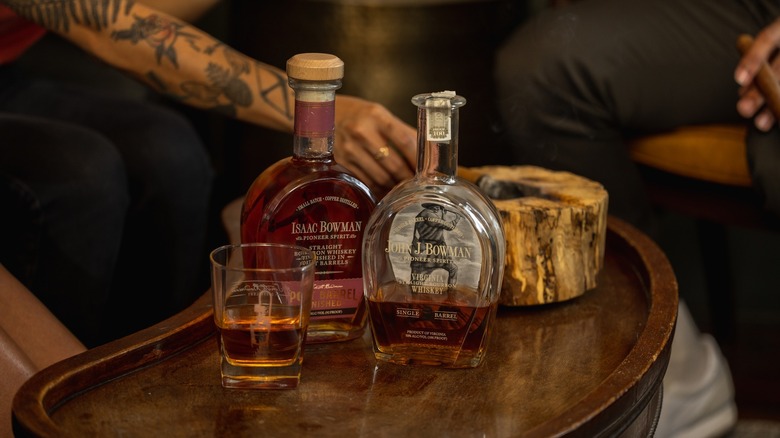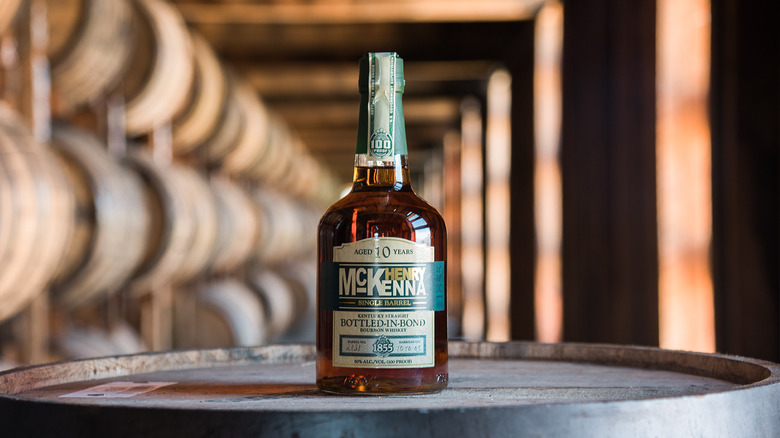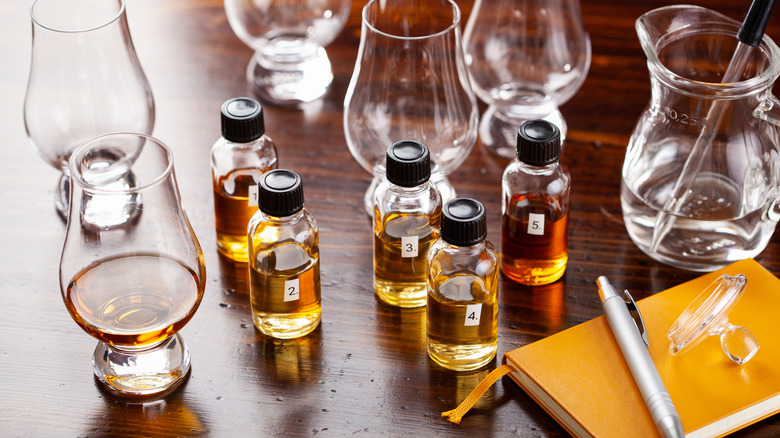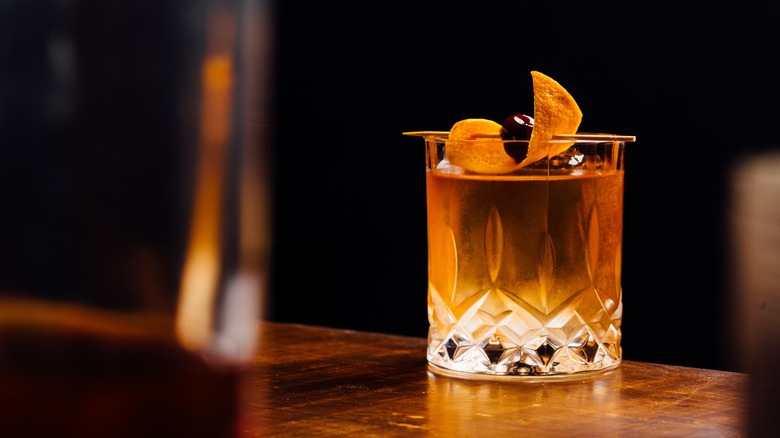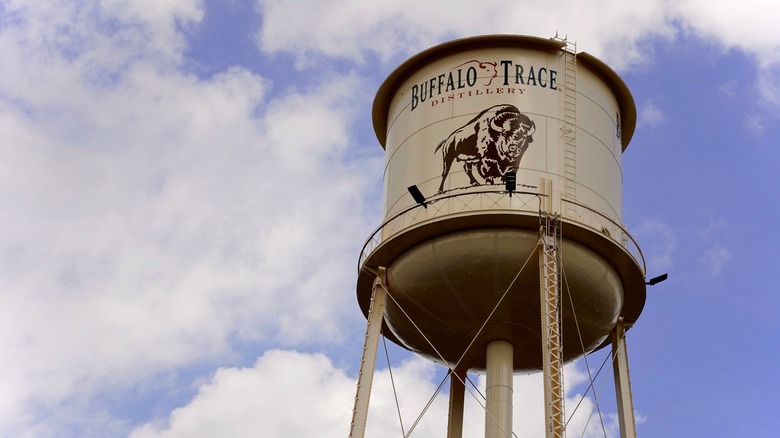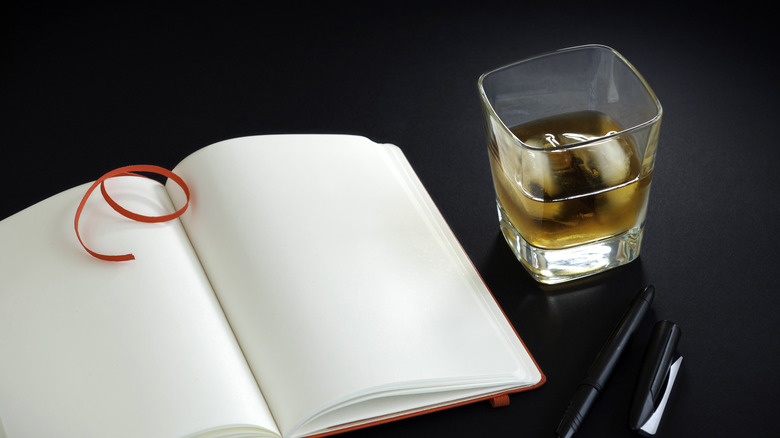13 Tips For Drinking Bourbon As A Beginner, From A Whiskey Connoisseur
If you're new to the world of bourbon, you're not alone. There are many people who are in the same boat, and you should take solace in the fact that even the most experienced of experts were once beginners. Anyone who is genuinely passionate about whiskey finds joy in sharing their wisdom, and I'm no different. That's why, after a decade of writing about varied types of whiskey, I'm here to share some expert insights and put you on the path to becoming a bona fide bourbon connoisseur.
I've tasted a huge range of bourbons, and wish I had someone to point me in the right direction when I was younger. All of these tips have been learned over my years of experience, as well as by talking to other bourbon enthusiasts and industry experts. With that in mind, I aim to deliver a helpful list packed with plenty of nuggets of information. Let's get started.
Learn what bourbon is
Before diving into the world of bourbon, it's important to know the basics. Not all whiskey in the United States is bourbon, but bourbon can only be made in the United States. The crucial legalities to know are that bourbon must contain at least 51% corn, be aged in new charred-oak barrels, and be distilled to no more than 160 proof.
There are a few other rules too, such as being bottled at a minimum of 80 proof and not having any additives. Bourbon has no official aging requirements, but to be called straight bourbon, the liquor must be matured for a minimum of two years.
There are many American whiskeys produced in ways that break at least one of these rules, so they are not counted as bourbon. For example, the difference between high-rye bourbon and rye whiskey is that the latter tipple is made with less than 51% corn. However, many bourbon lovers have a strong affinity for this spirit. Another interesting note is that some whiskeys technically qualify as bourbon, but their producers don't advertise them as such. The best example here is Jack Daniels, which the distillery prefers to market as Tennessee whiskey, but by law this product is bourbon. Knowing and checking out these differences is crucial to understanding the spirit.
Learn about mash bills and taste the difference
I mentioned that bourbon needs to be at least 51% corn, but that leaves a lot of room to maneuver. The mash bill is the makeup of the grains used in bourbon production. For bourbon, these grains consist of corn, wheat, rye, and malted barley. The percentages of these grains play a huge role in the bourbon's final flavor. A simplistic overview is that corn imparts sweetness, wheat offers smoothness, and rye gives you spice. Malted barley has its own flavors, such as nuttiness, but it's mainly included for its ability to provide fermentable sugars.
To complete this whirlwind lesson, all bourbons use corn in high amounts and malted barley in low amounts. The mash bill will then also include either wheat or rye, but not both. There are a few "four-grain" bourbons out there, but they are the exception. Due to this, we can find high-rye and wheated bourbons. It's important to try these out and understand the differences between them. Whatever bourbon you buy, look up the mash bill and see if your tasting notes reflect the different grain percentages. Eventually, you'll be able to estimate the mash bill percentages with new bottles without needing to look them up.
Don't believe the hype
Even if you're new to bourbon, you probably already know plenty of brand names. You have no doubt heard of the likes of Jim Beam and Maker's Mark, but maybe you also know that Pappy Van Winkle and Stagg have almost mythical status. Many of these brands deserve the reputation they have, and it's easy to gravitate toward them when picking up bottles, as there is comfort in familiarity. While these bourbons can be excellent, you'll find a different type of enjoyment from exploring lesser-known brands.
Famous bourbons can be expensive, and as a whiskey novice, it may not be prudent to invest in them. When getting started, explore the huge range of bourbons out there for you to enjoy. Many hidden gems will provide you with unique flavor profiles and exceptional quality. By venturing off the beaten path, you can support smaller producers and expand your bourbon knowledge even quicker.
The truth is that most people start with the big names — that's what I did. But eventually, take the time to discover a variety of bourbons. If you have the money to buy one bottle of famous bourbon or four bottles from lesser-known distilleries, it's probably best to opt for the lesser-known bottles at the start. When you develop your taste and palate, you can start treating yourself to the expensive stuff.
Try different types of bourbon
As touched on before, there are many types of bourbon to be explained. Straight bourbon is simply a spirit that meets all the criteria for bourbon, with a minimum aging of two years. Bourbon labeled as bottled-in-bond must be produced under stricter requirements. These are various rules stipulated by the Bottled in Bond Act of 1897, which include a minimum aging of four years, as well as having a minimum proof of 100.
Moving on from aging requirements, there are also single-barrel bourbons that are produced within only one barrel, rather than being a blend from multiple barrels. This can result in a more unique and complex bourbon. Small-batch bourbons are those which, unsurprisingly, have been made in a small batch, but in a unique blend derived from a number of barrels. Again, this can result in a unique tasting experience.
To quickly cover more types: Cask-strength bourbons are bottled from the barrel without any dilution, and full proof is bottled at the same proof that it had when entering the barrel; meanwhile, the non-aged liquor called white dog is not classified as true bourbon. And, as mentioned, there is also bourbon with different mash bills, which can result in wheated, high rye, and high corn bourbon. Bourbons can even qualify as several of these types at once. For example, one of the best top-shelf bourbons, Henry McKenna, markets itself as single barrel, straight, and bottled-in-bond.
Buy a proper tasting glass
The best tasting experience will come from a small tulip-shaped glass. Among the best glasses for sipping bourbon, the Glencairn glass is ideal for tasting. Choosing the right glass mainly comes down to aroma. The Glencairn glass has the perfect tulip shape to trap the aroma, before concentrating it on your nose when you tip the glass. This type of glass won't affect the taste, but it does allow you to more easily control the amount of bourbon you sip. Both of these factors are crucial in allowing yourself to have the best tasting experience.
Perhaps you are asking why the aroma is so important. For almost any bourbon drinker, including myself, the aroma is inexplicably linked to the tasting experience. Whiskey is my favorite smell; many would say the same. A proper tasting glass gives you the best possible chance to enjoy that aroma in all its glory. Should you always drink bourbon from a tasting glass? Absolutely not. However, a tasting glass is what you should use initially to form your opinion and pick out your tasting notes. Once you have done this, then you're free to try out a range of high-quality glassware before finding your favorite. For me, I always start out with a Glencairn glass before moving on to a crystal tumbler.
Check the proof
The proof is the alcohol content of your bourbon. This legally has to be a minimum of 80, but can be distilled up to 160 proof. As a beginner, it is easy to be overwhelmed by the heat of the bourbon as it dominates your mouth. You may feel an alcohol burn, and be unable to pick out more nuanced flavors. As you get used to drinking bourbon, this will change, and you'll become more adept at drinking high-proof whiskey.
Due to this, it's often best for beginners to start off with low-proof bourbons; fortunately, there are many great options out there. These bourbons tend to be smoother and easier to sip. This allows you to focus on the flavors without worrying about the heat. Eventually, you'll be able to enjoy higher-proof bourbon with bolder and more intense tastes. As you become more comfortable with different proofs, you can experiment with your bourbon and explore its complexity. You'll then be able to truly understand how proof affects the tasting experience.
Take small sips
If you were only familiar with drinking bourbon from movies and TV shows, you'd think the right way to drink whiskey would be by gulping it down. In reality, neat bourbon is there to be sipped and savored. As a beginner, you may be inclined to think that an expert would be at ease with swallowing large amounts of high-proof spirits at a time. However, the opposite is true. Experts will take small sips and spend time enjoying the drink.
Drinking large gulps at a time is a waste of bourbon. It will overwhelm your palate, and you won't be able to pick out the more subtle notes that will define the bourbon. Taking small sips allows the bourbon to roll across your tongue, so that you can appreciate the different layers of flavor. Taking your time with small sips will not only enhance your tasting experience, but it will also make your bottle of bourbon last longer, as you'll be savoring every drop.
Look beyond Kentucky
Kentucky bourbons are popular for good reason. The Bluegrass State produces the vast majority of bourbon in the country, and you could spend a lifetime of appreciating bourbons only from Kentucky. However, an increasing number of distilleries that are located outside of Kentucky make great bourbon. Try exploring what other regions have to offer. Illinois, Tennessee, Virginia, Texas, and New York are just a few of the states that provide some of the best bourbons that are not produced in Kentucky, and are well worth checking out.
The non-Kentucky bourbons will be influenced by the local climate, ingredients, and water sources. These can impart surprisingly different profiles from their Kentucky counterparts. Trying them allows you to expand your palate while also supporting the growing diversity of this industry. Branching out this way isn't something that you have to do immediately, as Kentucky bourbons are often the most accessible and affordable varieties available. However, you'll soon enjoy exploring the vast delights of what the rest of the United States has to offer.
Don't focus on age statements
There is a myth in the world of whiskey that age equals quality. While there can be a strong link between these characteristics, it's also far too simplistic of a statement. Good bourbon needs sufficient aging, but the craftsmanship that goes into the bottle is more important. For example, you could have a bad-quality six-year bourbon, but a high-quality four-year-old. During a recent visit to Buffalo Trace Distillery's new London digs, I spoke with Drew Mayville, the producer's master blender, who discussed some of the difficulties around age statements. Whiskey can age at different rates depending on the climate of its storage facility. Due to this, bourbon may reach its desired quality before reaching the age planned to be stated on the bottle. If this happens, the whiskey needs to be left in the barrel past its prime, as it can't be sold with an incorrect age statement.
There is a sentiment in the industry that spirits are ready when they're ready. Due to this, don't be put off by a bourbon not having an age statement. Equally, don't be charmed by a whiskey that does. For a little recap, straight bourbon needs to be aged for a minimum of two years, and bottled-in-bond bourbon for four. It's best to let your natural curiosity dictate your buying choices, rather than having rigid ideas about what you should be buying. Want to buy an aged whiskey to see how it compares to others? No problem — just don't buy it solely due to the number on the label.
Don't be afraid to add water
You may hear from some casual drinkers that you shouldn't add water to whiskey. While I think everyone should taste bourbon neat out of the bottle at least once, the assertion against adding water isn't true. Bourbon is rarely bottled as it comes from the cask, as barrel proof is just one of several types of bourbon. Most whiskey is watered down to meet a certain proof. This can be done for several reasons, one of them being that it makes it easier to drink and taste the nuanced flavors. Especially for beginner drinkers, high-proof spirits can be overpowering, as it can take a while to get used to the higher alcohol content.
If you buy a bourbon and feel that it's overpowering, don't automatically think you can't drink it. Instead, add a few drops of water and see how it opens up. In fact, you should do this with all bourbons, and not just those with a high proof. If you go to a tasting event, they'll often provide you with water and a dropper, allowing you to closely control the water you add. You can use either distilled or spring water for this, but the result can be hit or miss. For some bourbons, adding water can mute the flavors; for others, it can open up new ones. It's good to assess this and find out for yourself.
Experiment with bourbon
To fully appreciate the depths of bourbon, it needs to be sipped neat. But once you've enjoyed the subtle tasting notes, don't be afraid to experiment with your bourbon — and there are a few different ways to do this.
The most obvious option is to enjoy a bourbon-based cocktail. There are many wonderful options out there, with the mint julep, whiskey sour, old fashioned, and Boulevardier being some of the most famous. These drinks can showcase bourbon's rich flavors, but do so in a refreshing new way. You can even try and create a new cocktail using your ingredients at home.
But bourbon isn't just for drinks. There are many tips and tricks for cooking with bourbon, and as an ingredient it can be particularly brilliant in sauces, marinades, and even desserts. The rich complexity of bourbon can be transferred to a dish for added depth of flavor. Finally, there are many fantastic food pairings for bourbon you can try. Bourbon famously goes well with cheese and chocolate, but can also pair perfectly with nuts, ice cream, and brisket. Drinking whiskey neat is the way to enjoy it in its purest form, but try to expand your world of bourbon to see what other tastes you love with it.
Visit a bourbon distillery
You can learn everything you need to know about bourbon through articles and books, but there's nothing quite like visiting a distillery. This will give you an opportunity like no other to deepen your appreciation for this storied spirit. You'll be able to get a behind-the-scenes look at the techniques of whiskey production, including the selection of grains and the aging process. You'll get to see the craftsmanship firsthand, and depending on the distillery you visit, possibly speak with employees who are integral to production.
These craftspeople usually speak with passion and enthusiasm, and you'll be sure to come away learning something new. Each distillery is different, and it can be enlightening to see how they compare with each other. If you don't live near a bourbon distillery, that doesn't matter. Distilleries may be slightly different, but whiskey production is similar wherever you are. Find your local distillery and give it a visit. And at the end, you'll often get to join a tasting session, when you can sample a range of products. It all adds up to a brilliant experience, and one that is always worth the money spent.
Record your bourbon journey
My final tip is to record your bourbon journey. You can do this in any way that you like, with my personal preference being a spreadsheet. Keeping a detailed log of your tasting offers several benefits. First of all, it's a good tracker of all the different bourbons you've tried, allowing you to recall all the varieties you've enjoyed. It helps prevent you from buying the same bottle twice if you weren't a huge fan when you first tried it. Once you reach a certain stage of bourbon sampling, it can be hard to remember every bottle you've had. A quick check back to your notes solves this problem.
Keeping records will also allow you to track trends and preferences. This lets you see which types of bourbons you prefer, and examine how your favorite bottle evolves over the years. Knowing this, you can buy bourbons that align with your tastes — or alternatively, it encourages you to look outside your comfort zone. Finally, documenting your journey simply creates an enjoyable personal record. You can look at it with pride, and even show others your work. Eventually, you'll have a vast collection of notes that will become an integral part of your love of bourbon.
